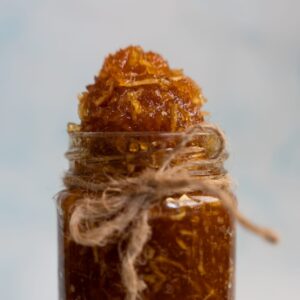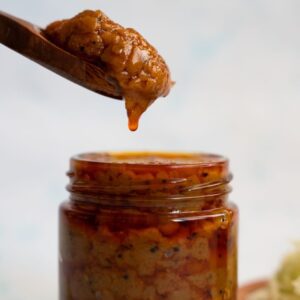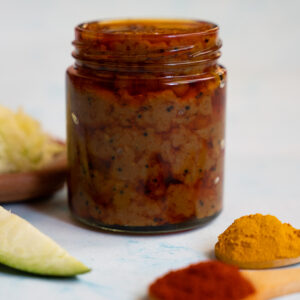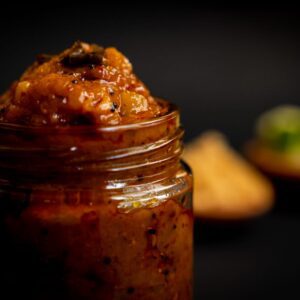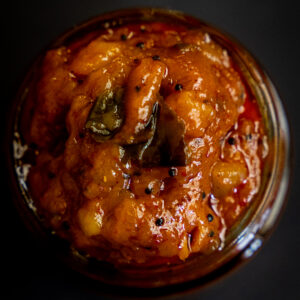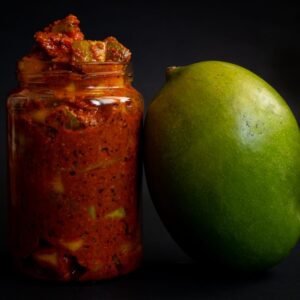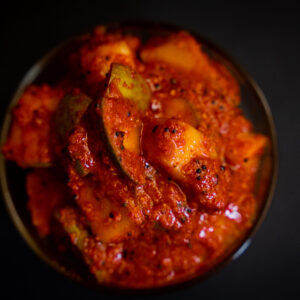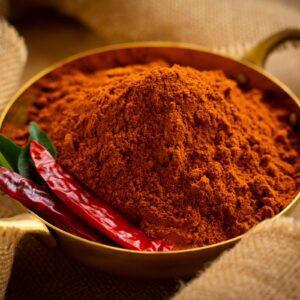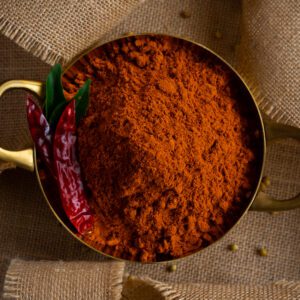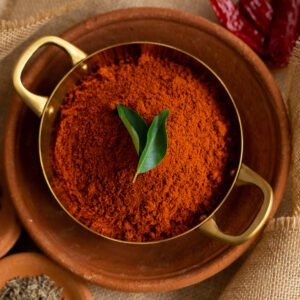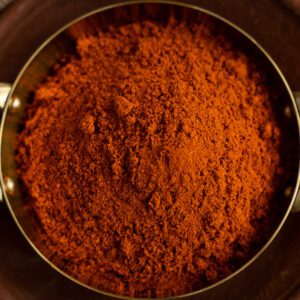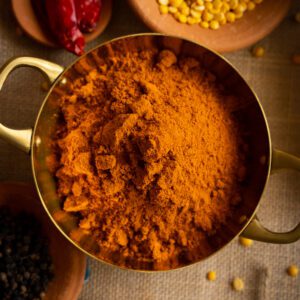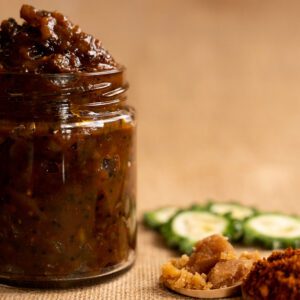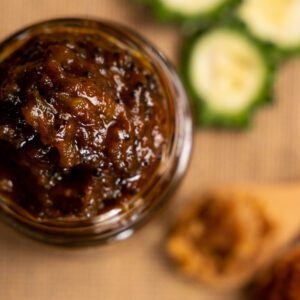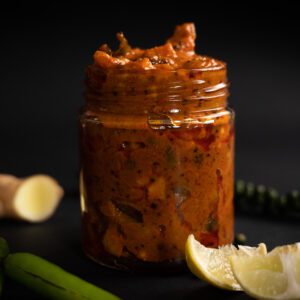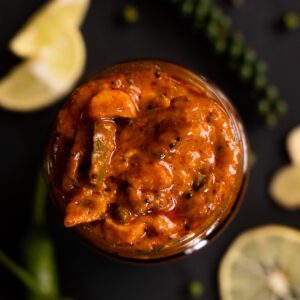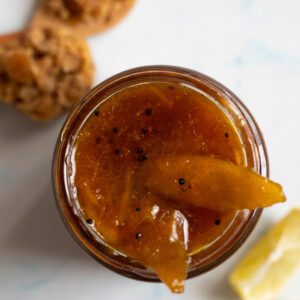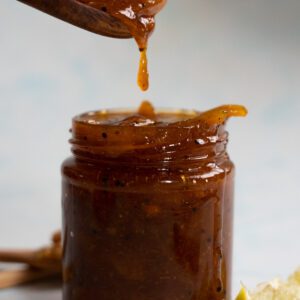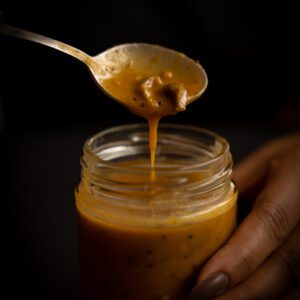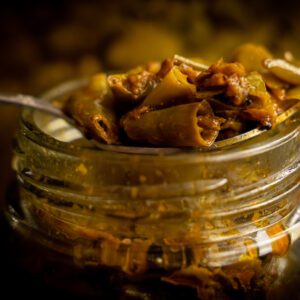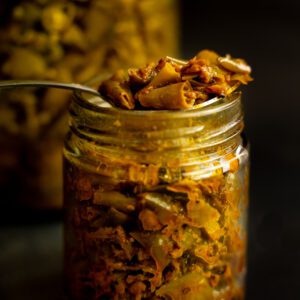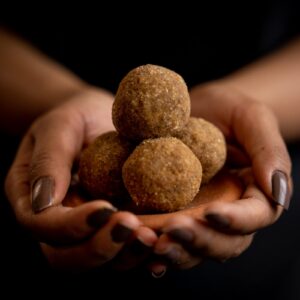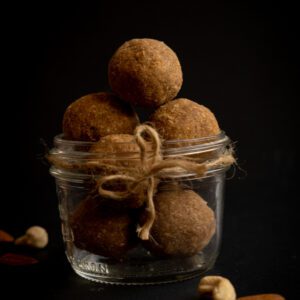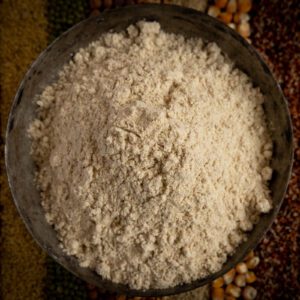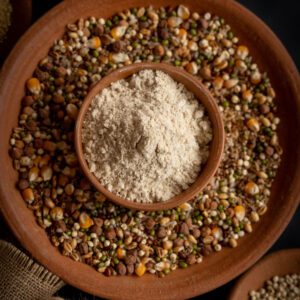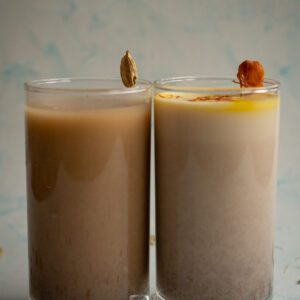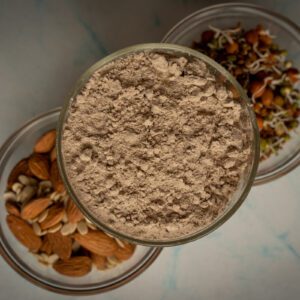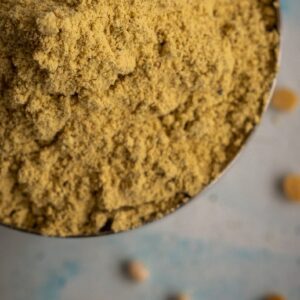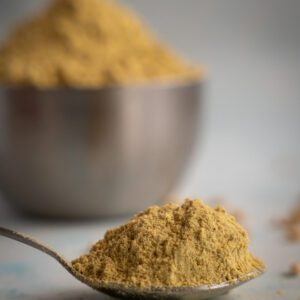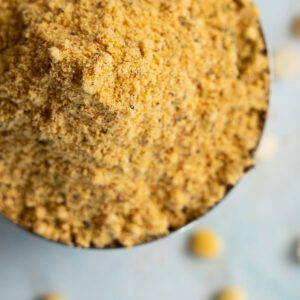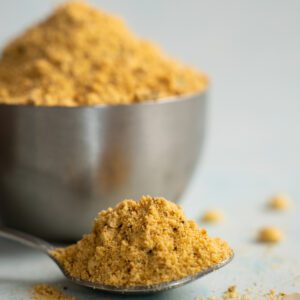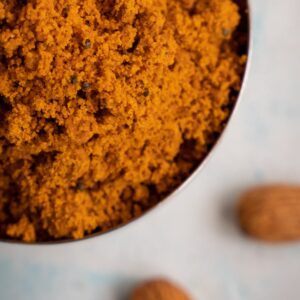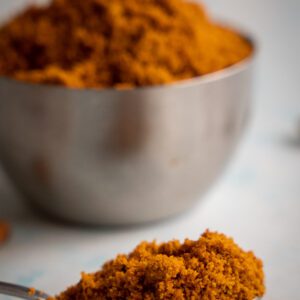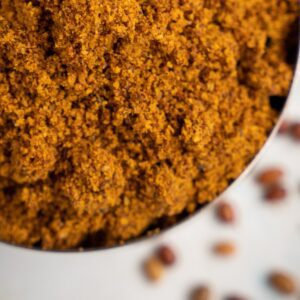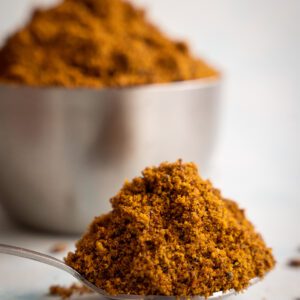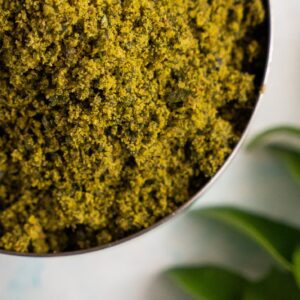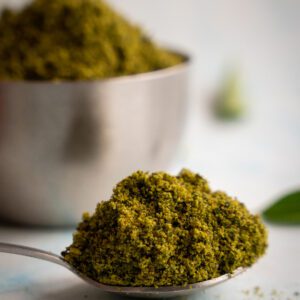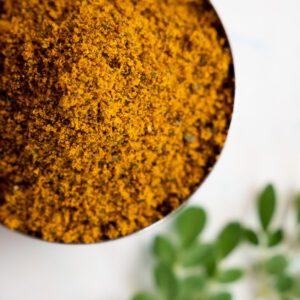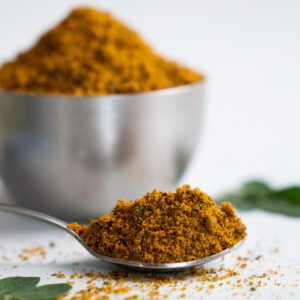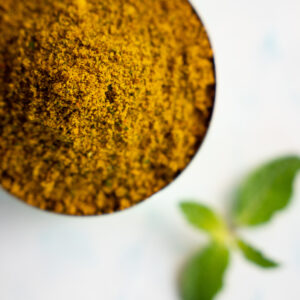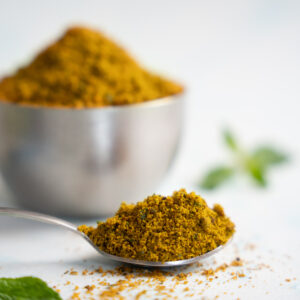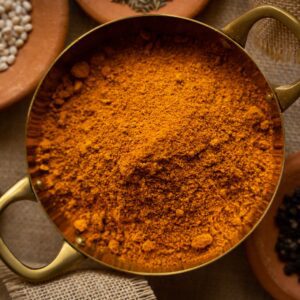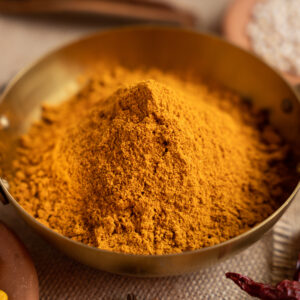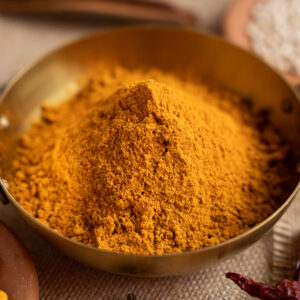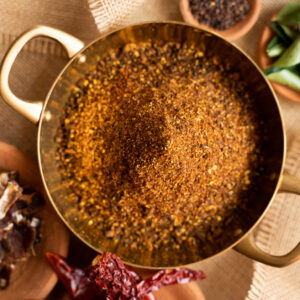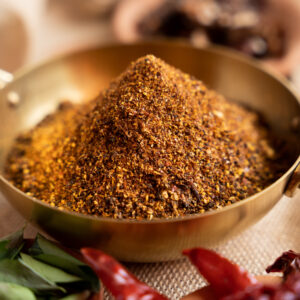
Milled Fresh

No Added Preservatives

100% Homemade with Love

No Added Colorants
Mango Items (Summer Special)
Mango Chunda
Our Product of the season is the Mango Chunda. This preserve recipe was originally given to me by my Gujarati neighbours who prepared every summer. I still remember tasting it for the first time and being blown away by how one dish could blend contradictory sweet—spicy—sourness to create the perfect harmonious burst of flavours.
Over the years I’ve added my own magic to the recipe to create the perfect Indian mango preserve. Suvidha’s chunda is made with grated raw mango, sugar, fresh ground chilli powder and special spices that truly set it apart from any store bought pickle or jam.
It’s best eaten as a side dish or as a spread. Whenever my daughters had early flights to catch, they would always make sure to carry chapati rolls or bread slices generously smeared with this jammy spread.
Maavinkayi Thokku
The Suvidha Maavinkayi thokku is made with grated raw mangoes and fresh ground chilli powder. While a mango pickle includes raw ingredients that are preserved together, and over time, chemically react with each other to produce the tangy–spicy taste we love, a thokku is actually cooked low and slow over a flame to produce rich and complex flavours that will blow you away as soon as you taste it.
This is a traditional south Indian thokku recipe that has been passed down to me from my mother. My daughter’s love for spicy food began when she first tasted this thokku and immediately smacked her tongue in delight.
In the summer months, a bowl of cold mosaru anna (curd rice) is incomplete without this delectably spicy companion. You can also eat it with hot crispy dosas and a dollop of ghee.
Maavinkayi Gojju
The art of gojju making involves perfectly balancing contradictory sweet—sour—spicy flavours to create a complex tangy gravy. This is a skill I have perfected over the years and the Suvidha mango gojju is a traditional Kannadiga recipe passed down to me from my mother.
What sets this gojju apart from the other store bought ones is the use of the specific breed of mangoes, fresh jaggery and dry coconut.
This can be eaten along with dosas, chappatis and curd rice but personally I love ladling the gojju onto hot rice with just a dollop of melted ghee. The aroma itself will transport you straight to summertime at your grandmother’s house.
Raw Mango Upinkayi
Nothing is more synonymous with Indian summertime than fat juicy mangoes and for decades now, my sisters and I have welcomed the season every year by making our signature batch of raw mango uppinkayi (raw mango pickle).
Suvidha’s uppinkayi is prepared with specially procured Amlet mangoes grown in South India. It’s distinct salty–spicy–sour flavour is soaked up thoroughly by big chinks of this juicy mango making every bite memorable.
My daughters love eating the uppinjayi with chapati and dosas but for the ultimate culinary experience, we recommend adding a spoonful to your curd rice and slurping it up with every bite.
Signature Masaale
Rasam Powder
The Suvidha Rasam Powder is a staple family soul-food recipe that will help you recreate the taste of amman kayyin saaru.
With a perfect balance of tangy and spicy, the rasam you prepare with this powder will clear out blocked sinuses and make you smack your tongue in delight.
I still remember my father sipping it directly from a tumbler before slurping it up with rice and we recommend you do the same for the ultimate culinary experience.
I personally enjoy adding this to the various types of rasams I make—be it tomato, tamarind, channa stock or even lemon rasam.
Instant Rasam Mix
Gone are the days of labouring over your stove to brew the perfect pot of rasam.
With our Instant Rasam Mix, even someone with the culinary skills to boil water will be able to produce a rasam that would make even their ajji proud.
I developed this recipe when my second daughter moved to another city for her job. Knowing how busy, and homesick she would be, living away from her family for the first time, I sent her a packet of this mix to tide her through hurried mornings and lonely nights.
You can prepare a plain rasam by just adding this powder to boiling water but I recommend adding some tomato chunks or pulp for added flavour.
Sambar Powder
This is not just a sambar powder.
This is the magic ingredient which will transform an ordinary sambhar you make into an unforgettable culinary adventure for anyone who tastes it.
This recipe was passed down to me from my mother who learnt it from her mother. I still remember watching her as she would gather the fresh spices from the village market, carefully measure it with a keen eye and pound it into a fine powder with the pestle and mortar.
Just a spoonful could transform a pot of vegetables, tamarind pulp, dal and turmeric into a divine sambar you’ll find yourself slurping down hungrily.
I often prepare this with watery vegetables like pumpkin and bottle gourds, leafy greens like amaranth or even kitchen staples like potato and onion!
Signature Pickles (Seasonal)
Haagalkaayi Gojju
My signature Haagalkaayi gojju recipe marries the nutty bitterness of haagalkaayi (bitter gourd) with the sweet, tangy, spicy intensity of the gojju gravy to create a symphony on your tongue.
Haagalkaayi boasts of many health benefits. It contains very high levels of Vitamin A and C content and is believed to have the ability to reduce blood sugar* levels in diabetic patients.
This dish is perfect for anyone who wishes to reap the rewards of the bitter gourd without subjecting your palate with its overwhelming bitterness.
In our house, a bowl of mosaru anna (curd rice) or a plate of dosas is incomplete without this gojju.
Lemon Pickle
The Suvidha signature spicy Lemon pickle is made with locally sourced mangai-inji, crispy green peppers, spicy green chillies, fresh ground red chilli powder and the tangiest of lemons. This is a traditional recipe passed down to me from my own mother who would spend the months leading up to the summer pickling the lemons from our farm.
My siblings and I would welcome summertime by fighting over the biggest pieces of lemon to suck on straight from the jar.
The spicy tangy burst of the Suvidha Lemon pickle will perfectly accompany a bowl of cold mosaru anna (curd rice) and even flaky, buttery parathas.
Sweet Lemon Pickle
The recipe for this Sweet Lemon Pickle came about completely serendipitously. One of our clients, a marwadi woman living in Bangalore, really missed her mother’s traditional sweet lemon pickle. Unable to find it in any shop, she came to me with a custom request.
So I created this special recipe and made just one bottle for her, to fulfil her hunger for nostalgia. Little did I know just how popular it would become. Soon orders began pouring in and so here it is: the Suvidha signature (surprise) Sweet Lemon Pickle.
This perfectly pairs hot chappatis and flaky parathas.
Raw Tamarind Rasa
This Raw Tamarind Pickled Rasa is a very old recipe that has been passed down through generations in my family.
We crush raw tamarind and mix it with red/green chilli, dash of methi and mustard to produce the perfect rasa that’s both hot and sour. Your taste buds will rejoice and we promise it’ll leave you licking your fingers in a way that some people may disapprove of, but we thoroughly encourage.
We recommend treating this like any other pickle! You can eat it with dosas, akki rotti, parathas and chapatis or even mix it with some hot rice and ghee.
Chilli Pickle
The Suvidha Chilli Pickle is the perfect companion for every meal! You can eat it with your akki rottis or parathas or straight from the bottle if you truly dare. The tang and spice from the pickle will nicely compliment every dish while adding just a bit of spice to it.
I have always been a sucker for spice and anytime anyone made a chilli pickle, I would eagerly taste some. From store bought, to homemade, I found something lacking in all the chilli pickles I had tasted so I decided to make one of my own that could satisfy my taste buds.
My children graciously indulged me, trying multiple batches of sub-par pickles until we stumbled upon this signature recipe that is sure to leave you gobsmacked!
Super Foods
Health Unde (Wheat)
Can a snack be both healthy and tasty? If you said no, then the Suvidha Unde is here to prove you wrong! This is our #lifehack to never feeling guilty while munching on laddoos. It’s so good, we encourage having more than one and we promise you won’t even have to go up a belt notch.
This recipe was passed down from my sister who used to make it as an after school snack for my niece and nephew. Now, I give this to my granddaughter as soon as she comes home from school to eat with a tall glass of cold milk.
This is also a perfect snack to carry with you on trips and picnics, just as we did when I was young!
Health Unde (Dry fruits)
Can a snack be both healthy and tasty? If you said no, then the Suvidha Unde is here to prove you wrong! This is our #lifehack to never feeling guilty while munching on laddoos. It’s so good, we encourage having more than one and we promise you won’t even have to go up a belt notch.
This recipe was passed down from my sister who used to make it as an after school snack for my niece and nephew. Now, I give this to my granddaughter as soon as she comes home from school to eat with a tall glass of cold milk.
This is also a perfect snack to carry with you on trips and picnics, just as we did when I was young!
Suvidha Special Hittu
Our Suvidha Special Hittu is high on protein, iron and vitamins, providing you with the nutrition and energy you need to power through dreary days!
I make this flour by combining 4 millets, 4 grains and 4 pulses. This is an ideal super food suitable for breakfast or even your pre or post workout meal.
When I underwent knee surgery a few months ago, doctors had advised me to include a protein rich diet to recuperate faster. I developed this powder recipe after consulting with my physiotherapist. I used it to make rotti, dosa and even thalipeet by mixing it with veggies and water as per the requirement.
This ended up becoming a pre/post workout food for my youngest daughter who is a dancer and actor and by default needs highly nutritious food. Even my granddaughter loves the rotti I make with this powder!
Added note: This is suitable for senior citizens as well.
Health Drink Mix
The Suvidha Health Drink is a pulses malt that will pump you up with the protein power you need to conquer the world. People of all ages (above 6 months) can drink it either with water or milk. We recommend having it with your morning breakfast or after a workout to kickstart your day.
When my kids were younger, I was in search of the perfect after school drink that could replenish their energy. I found that most protein/malt drinks that were available in the market contained high levels of sugar/sucrose and were unhealthy for consumption.
I developed this powder mix as an organic homemade alternative after consulting an Ayurvedic doctor. The Suvidha Health Drink Mix is made by combining ground dried sprouted pulses and dry fruits and is even more tasty than any drink mix you can buy from a supermarket.
Chutney Pudi's
Bele (Dal) Chutney Pudi
The Suvidha Bele (Dal) Chutney Pudi has all the nutty goodness of kadle (channa dal) and the mild spicy flavour of a chutney pudi.
This pudi was a recipe I developed for my granddaughter. As a child, whenever she saw us adults eating spicy pudi’s with our rice, she would want to taste some as well. So I set out to create a pudi with a balanced note of spice.
Bele (Dal) Chutney was the perfect ingredient that also fulfilled my granddaughter’s protein intake with every bite.
As with any chutney pudi, we recommend adding a little ghee or oil and eating it with dosa, ildi or akki roti. In addition, you won’t want to miss eating this with some hot rice with a dollop of ghee melted on it!
Hurgadle Chutney Pudi
The Suvidha Hurgadle Pudi has all the nutty goodness of kadle (channa dal) and the mild spicy flavour of a chutney pudi.
This pudi was a recipe I developed for my granddaughter. As a child, whenever she saw us adults eating spicy pudi’s with our rice, she would want to taste some as well. So I set out to create a pudi with a balanced note of spice.
Hurgadle (channa) was the perfect ingredient that also fulfilled my granddaughter’s protein intake with every bite.
As with any chutney pudi, we recommend adding a little ghee or oil and eating it with dosa, ildi or akki roti. In addition, you won’t want to miss eating this with some hot rice with a dollop of ghee melted on it!
Badam Chutney Pudi
The Suvidha Badam Pudi has all the nutty goodness of almonds and the intense flavour of a chutney pudi.
This pudi was a recipe I developed for my grandson. As a child, whenever he saw us adults eating spicy pudi’s with our dosas/idlies, he would want to taste some as well. So I set out to create a pudi that carried a hint of sweetness to offset the usual spice.
Badami or almonds were the perfect ingredient that also fulfilled my grandson’s nut protein intake with every bite.
As with any chutney pudi, we recommend adding a little ghee or oil and eating it with dosa, ildi or akki roti. If you’re a fan of eating hot chapatis with ghee and sugar, we recommend swapping that out for this yummy pudi!
Horse Gram Chutney Pudi
This protein rich chutney pudi is made with horse gram, a traditional superfood used in Kannadiga cuisine. The lentil is so rich in protein that it was fed to race horses to pump them up with the energy needed to run faster.
Known as a miracle pulse, this pudi was recommended to me by my doctor after my knee surgery since it’s known to reduce joint inflammation and pain. Additionally it has anti-bacterial properties and is low on the hyperglycemic index.
As with any chutney pudi, we recommend adding a little ghee or oil and eating it with dosa, ildi, akki roti or even chapatis!
Curry Leaf Chutney Pudi
Curry leaves, known for their medicinal and culinary properties, also have a bitter taste and pungent smell.
When my daughters were young they detested it and often removed the whole leaves I’d added to the sambhar or rasam despite knowing how good it was at promoting hair growth and blood cleansing. In my attempt to include it in their diet nonetheless, I developed this curry leaf pudi recipe retaining the toasty notes of bitterness and all the nutrition of this magical leaf.
As with any chutney pudi, we recommend adding a little ghee or oil and eating it with dosa, ildi, akki roti or even chapatis!
Moringa Leaves Chutney Pudi
This recipe for this moringa leaf chutney pudi was initially requested by a client of ours who wanted to increase her intake of the nutrient rich soppu without having to deal with its signature bitterness. When she fell in love with the taste of the pudi and requested we make more, the official power-packed recipe was born.
Moringa, naturally rich in antioxidants, protein and vitamins A and C is dried, ground and blended with channa dal and other grams and spices to create a balanced chutney pudi that can be eaten along with idlis, dosas and even with piping hot plain rice and ghee.
Pudina Chutney Pudi
The recipe for the Suvidha Pudina Chutney Pudi was created and passed down by my mother and is known for its unique and complex flavours.
Pudina is known for being rich in antioxidants and Vitamin A. Traditionally, it has also been used to aid digestion.
As with any chutney pudi, we recommend adding a little ghee or oil and eating it with dosa, idly or akki roti. In addition, you won’t want to miss eating this with some hot rice with a dollop of ghee melted on it!
Instant Pudi's
All Purpose Palya Pudi
To all parents out there whose children refuse to eat vegetables, or who’re just struggling to include a variety of vegetables in their children’s diets- I present to you my All Purpose Palya Pudi!
When my children were younger, I realised that the masalas (chilli powder, garam masala etc.) I was adding to my palyas (vegetable side dishes), were probably too harsh for their tender stomachs. The taste too was getting monotonous. So I came up with the recipe for this pudi which includes roasted channa dal powder for added protein.
Adding just 1 ½ spoons of this pudi will take your dry roast palyas to a whole new level. We recommend using this for aloo palya, beans palya, kovakkai palya to name a few.
We endearingly call it All Purpose Pudi at home because it can even be used as an alternative to sambhar powder if you’ve run out.
This was a staple in my daughter’s kitchen when she was living alone and working long and exhausting hours and needed to throw together a quick yet tasty meal!
Instructions to use:
- Once you have prepared the plain fried vegetables of your choice, add 1½ to 2 tablespoons of the palya pudi along with some salt and mix thoroughly
- Additionally, you can add a pinch of jaggery or sugar along with some desiccated coconut for added flavour!
Vangi Bath Pudi
Vangi Bath, or brinjal rice is a traditional Kannadiga mixed-rice dish that is well loved in my family.
I developed the recipe for this instant mix powder to help people who might not have a lot of time to spare for cooking. Traditionally this is prepared with the long green brinjals and potato slices but I also add green capsicum when I prepare Vangi Bath at home.
This pudi however, can also be used for preparing baingan ka bharta or other stuffed vegetable dishes! I also add it when I prepare the South Indian pulav (or pallavu as it is colloquially known here), or even tomato rice, to increase intensity in flavour!
Instructions to use:
- Once you have prepared your fried brinjal (including any other vegetables you may wish to add), add 1½ tablespoons* of the vangi bath powder along with some rice and mix thoroughly
- Add the boiled rice to this vegetable mixture and fold through thoroughly
- Additionally, you can add a spoonful of ghee and some desiccated coconut for added flavour!
*1½ tablespoons per cup of raw rice used
Puliyogare Pudi
I developed the recipe for this puliyogare pudi to recreate the exact taste of the temple prasada puliyogare that we all love!
Growing up, my mother would make sure that our kitchen always had either the puliyogare pudi or paste, ready to use! No picnic was complete without a box of the flavourful tamarind rice.
I first started selling it in small batches when I moved to Bangalore more than a decade ago. Almost immediately it became a neighbourhood favourite and people would come over to buy it often!
Since it doesn’t spoil easily, and can be prepared instantly with very little effort, puliyogare as a dish is travel friendly and every bachelor’s best friend.
We recommend adding a few toasted peanuts and channa dal for the added crunch!
Instructions to use:
- Once you have roasted some peanuts along with your base oggarane*, add 1½ to 2 tablespoons** of the puliyogare pudi and fry it lightly in the oil over a medium flame
- Add the boiled rice to this mixture and fold through thoroughly
- Additionally, you can add some desiccated coconut for added flavour!
*Base oggarane: Mustard seeds, split urad dal, hing, dry red chillies, curry leaves
**1½ tablespoons per cup of raw rice used which can be altered as per your spice tolerance

